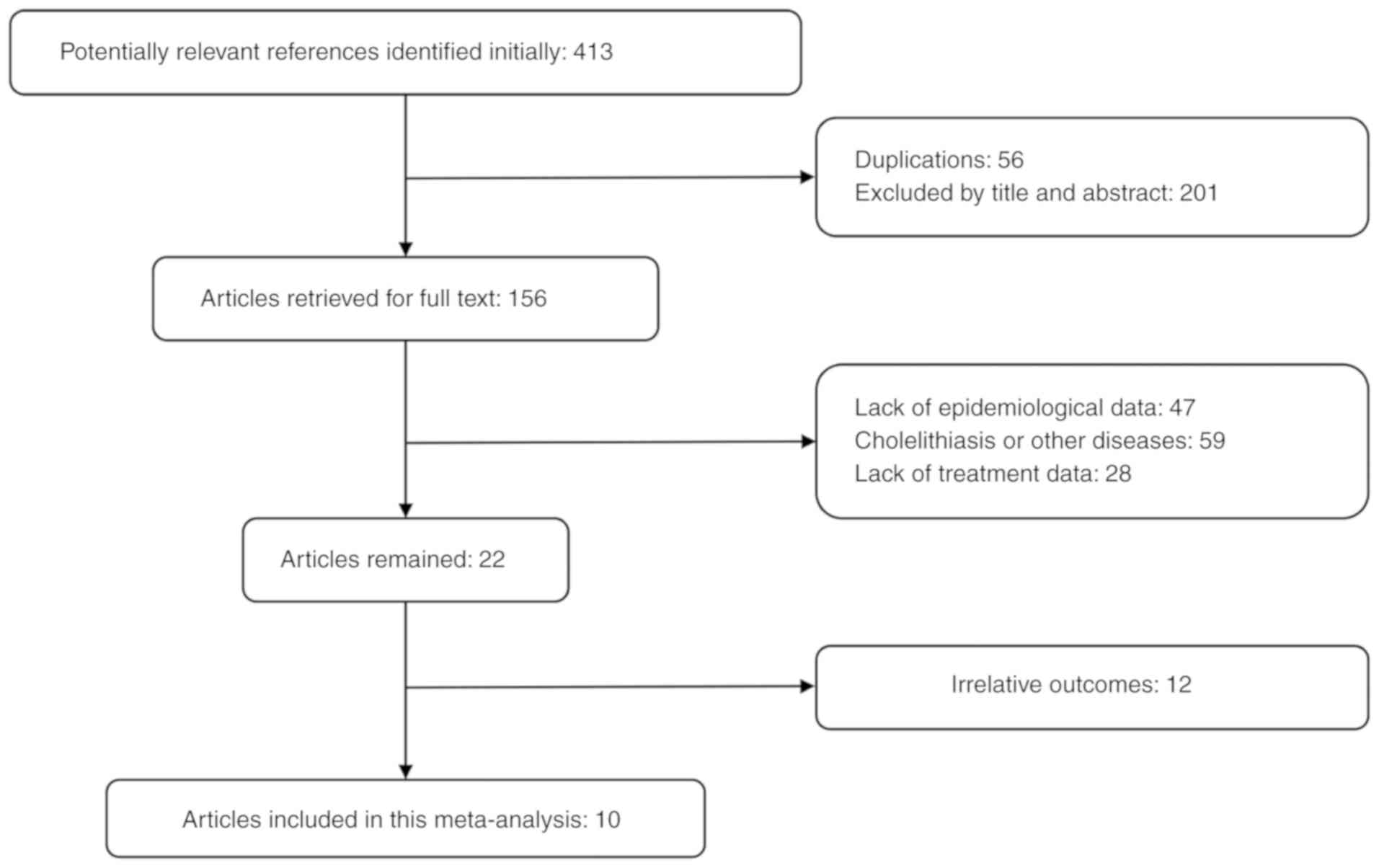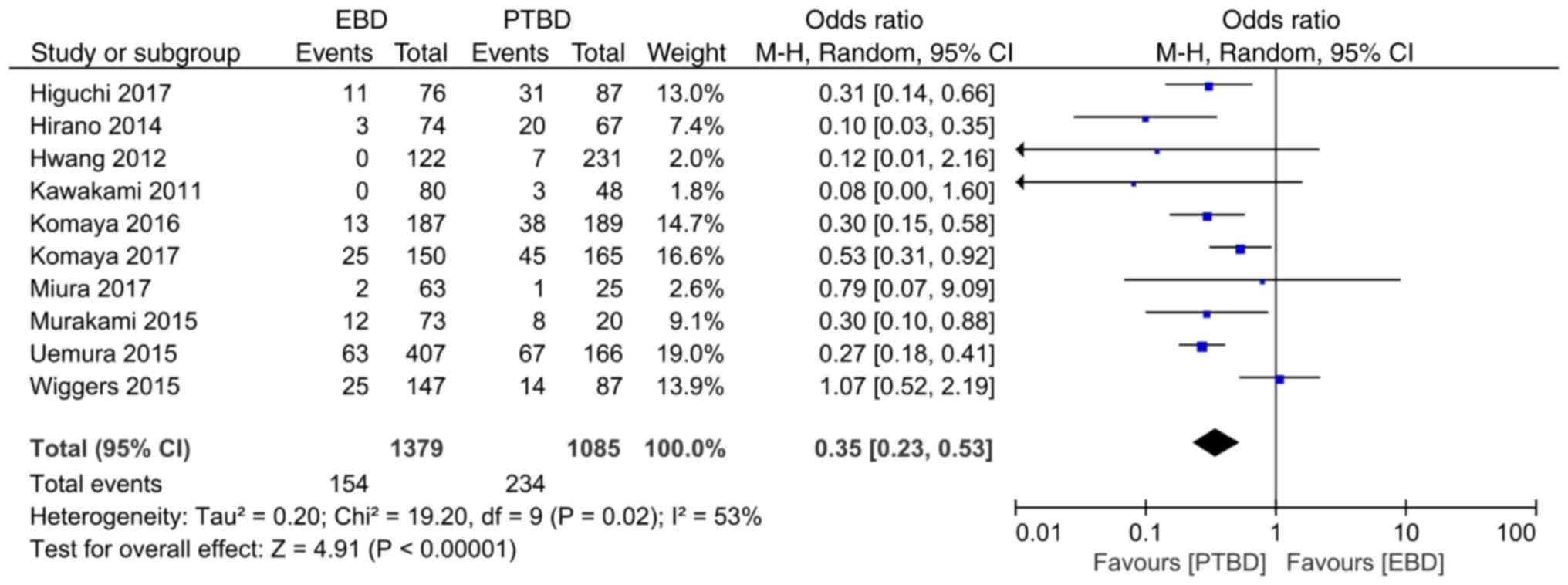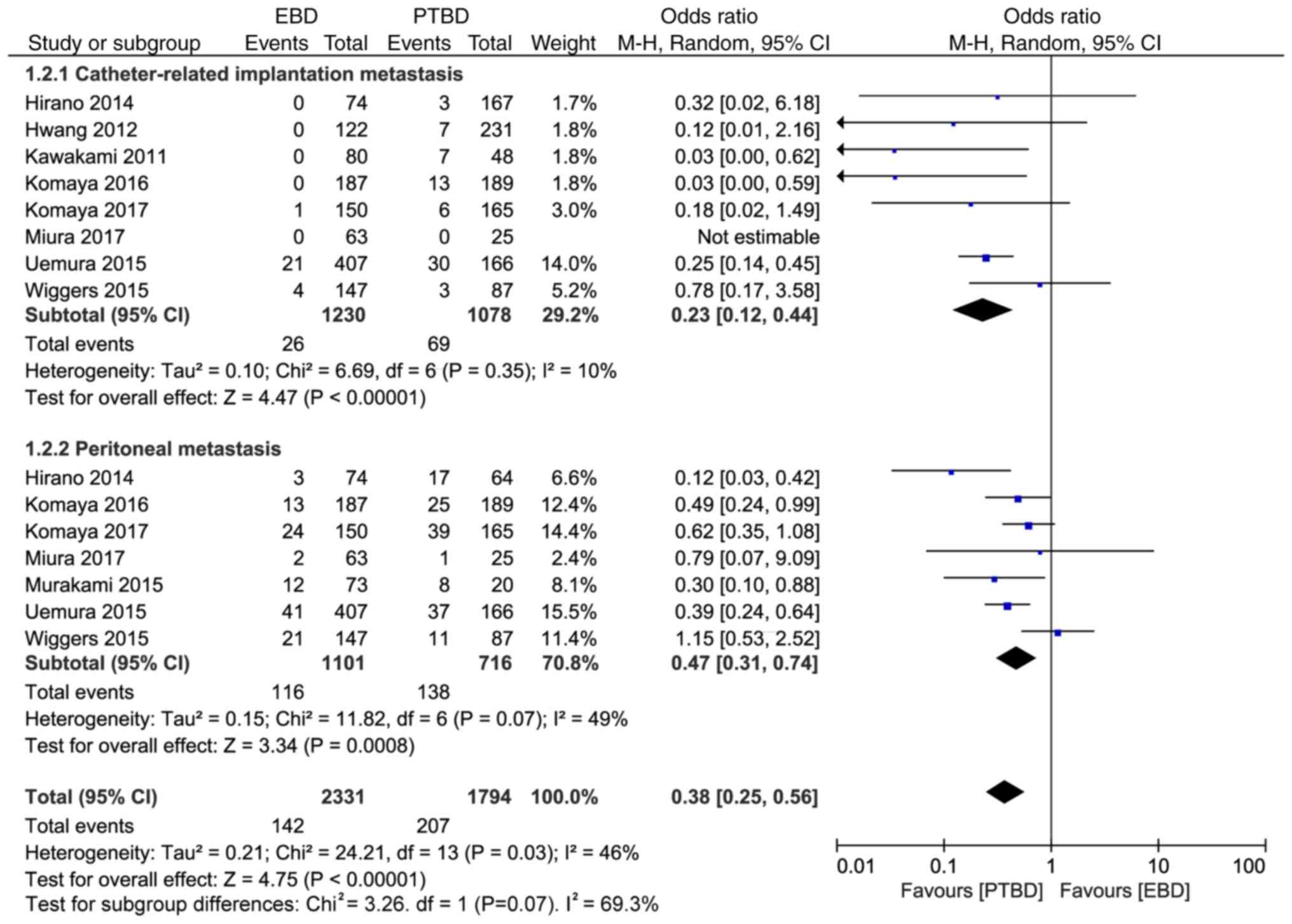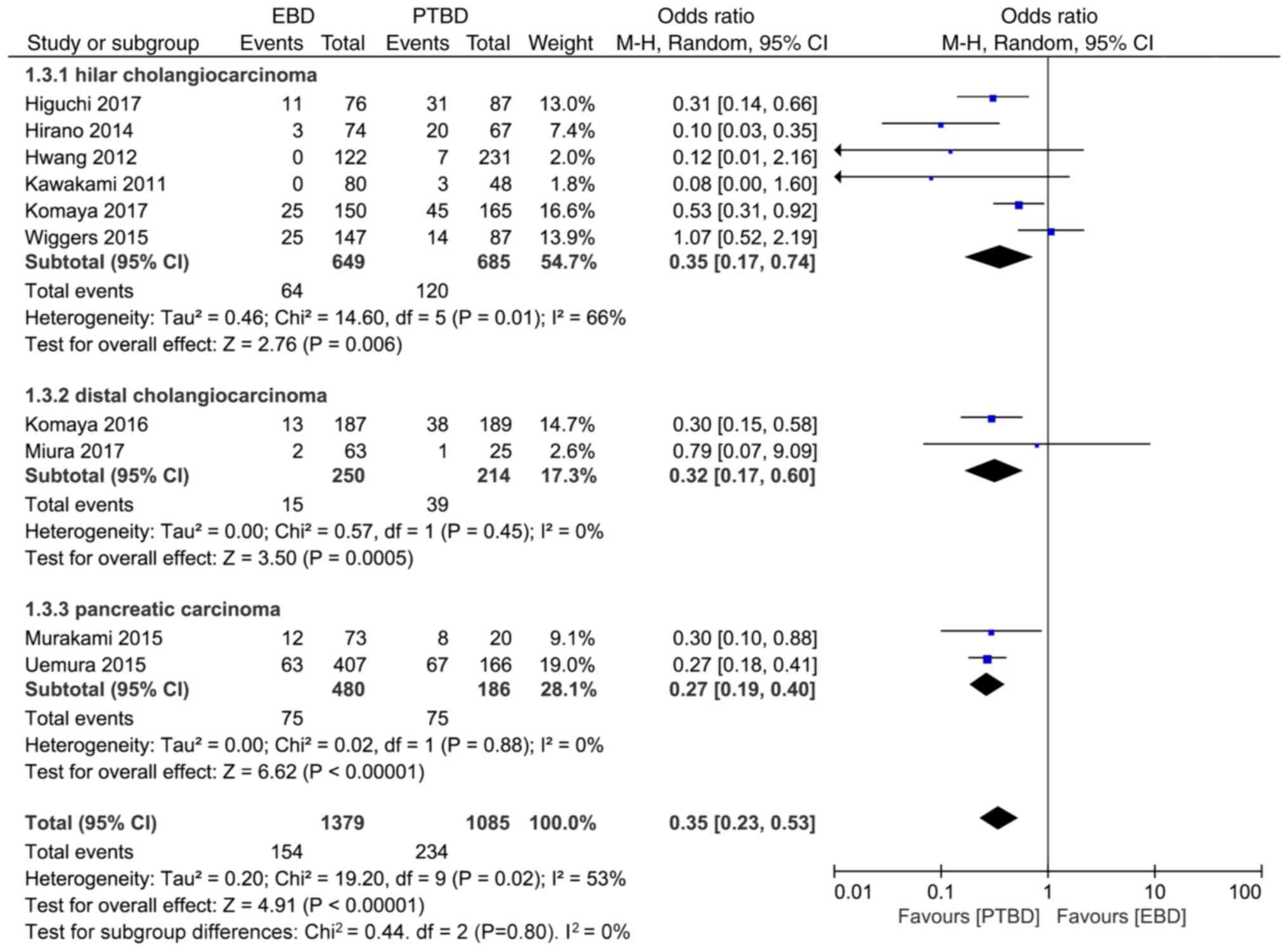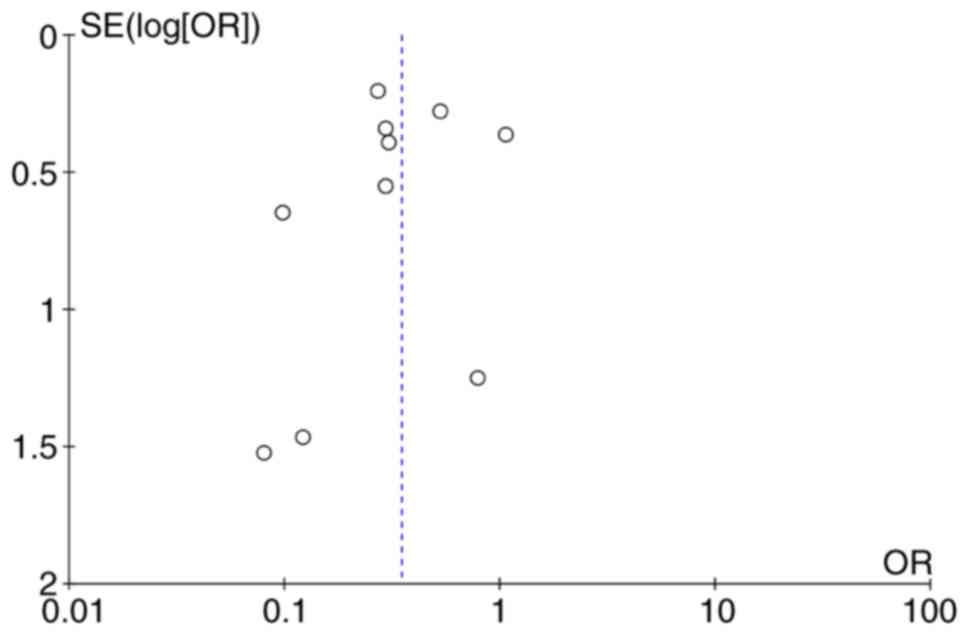|
1
|
Chandrashekhara SH, Gamanagatti S, Singh A
and Bhatnagar S: Current status of percutaneous transhepatic
biliary drainage in palliation of malignant obstructive jaundice: A
review. Indian J Palliat Care. 22:378–387. 2016. View Article : Google Scholar : PubMed/NCBI
|
|
2
|
Xu X, Li J, Wu J, Zhu R and Ji W: A
systematic review and meta-analysis of intraluminal brachytherapy
versus stent alone in the treatment of malignant obstructive
jaundice. Cardiovasc Intervent Radiol. 41:206–217. 2018. View Article : Google Scholar : PubMed/NCBI
|
|
3
|
Lorenz JM: Management of malignant biliary
obstruction. Semin Intervent Radiol. 33:259–267. 2016. View Article : Google Scholar : PubMed/NCBI
|
|
4
|
Fukasawa M, Takano S, Shindo H, Takahashi
E, Sato T and Enomoto N: Lorenz JM. Management of malignant biliary
obstruction. Clin J Gastroenterol. 10:485–490. 2017. View Article : Google Scholar : PubMed/NCBI
|
|
5
|
Hucl T: Malignant biliary obstruction. Cas
Lek Cesk. 155:30–37. 2016.(In Czech). PubMed/NCBI
|
|
6
|
Tibble JA and Cairns SR: Role of
endoscopic endoprostheses in proximal malignant biliary
obstruction. J Hepatobiliary Pancreat Surg. 8:118–123. 2001.
View Article : Google Scholar : PubMed/NCBI
|
|
7
|
Hameed A, Pang T, Chiou J, Pleass H, Lam
V, Hollands M, Johnston E, Richardson A and Yuen L: Percutaneous
vs. endoscopic pre-operative biliary drainage in hilar
cholangiocarcinoma-A systematic review and meta-analysis. HPB
(Oxford). 18:400–410. 2016. View Article : Google Scholar : PubMed/NCBI
|
|
8
|
Matsumoto K, Takeda Y, Onoyama T, Kawata
S, Kurumi H, Koda H, Yamashita T and Isomoto H: Endoscopic
treatment for distal malignant biliary obstruction. Ann Transl Med.
5:1902017. View Article : Google Scholar : PubMed/NCBI
|
|
9
|
Wiggers JK, Groot KB, Coelen RJ, Doussot
A, van Dieren S, Rauws EA, Schattner MA, van Lienden KP, Brown KT,
Besselink MG, et al: Percutaneous preoperative biliary drainage for
resectable perihilar cholangiocarcinoma: No association with
survival and no increase in seeding metastases. Ann Surg Oncol. 22
(Suppl 3):S1156–S1163. 2015. View Article : Google Scholar : PubMed/NCBI
|
|
10
|
Stang A: Critical evaluation of the
newcastle-ottawa scale for the assessment of the quality of
nonrandomized studies in meta-analyses. Eur J Epidemiol.
25:603–605. 2010. View Article : Google Scholar : PubMed/NCBI
|
|
11
|
Higuchi R, Yazawa T, Uemura S, Izumo W,
Chaudhary RJ, Furukawa T and Yamamoto M: ENBD is associated with
decreased tumor dissemination compared to PTBD in perihilar
cholangiocarcinoma. J Gastrointest Surg. 21:1506–1514. 2017.
View Article : Google Scholar : PubMed/NCBI
|
|
12
|
Hirano S, Tanaka E, Tsuchikawa T,
Matsumoto J, Kawakami H, Nakamura T, Kurashima Y, Ebihara Y and
Shichinohe T: Oncological benefit of preoperative endoscopic
biliary drainage in patients with hilar cholangiocarcinoma. J
Hepatobiliary Pancreat Sci. 21:533–540. 2014. View Article : Google Scholar : PubMed/NCBI
|
|
13
|
Hwang S, Song GW, Ha TY, Lee YJ, Kim KH,
Ahn CS, Sung KB, Ko GY, Kim MH, Lee SK, et al: Oncological benefit
of preoperative endoscopic biliary drainage in patients with hilar
cholangiocarcinoma. World J Surg. 36:379–385. 2012. View Article : Google Scholar : PubMed/NCBI
|
|
14
|
Kawakami H, Kuwatani M, Onodera M, Haba S,
Eto K, Ehir N, Yamato H, Kudo T, Tanaka E, Hirano S, et al:
Endoscopic nasobiliary drainage is the most suitable preoperative
biliary drainage method in the management of patients with hilar
cholangiocarcinoma. J Gastroenterol. 46:242–248. 2011. View Article : Google Scholar : PubMed/NCBI
|
|
15
|
Komaya K, Ebata T, Fukami Y, Sakamoto E,
Miyake H, Takara D, Wakai K and Nagino M; Nagoya Surgical Oncology
Group, : Percutaneous biliary drainage is oncologically inferior to
endoscopic drainage: A propensity score matching analysis in
resectable distal cholangiocarcinoma. J Gastroenterol. 51:608–619.
2016. View Article : Google Scholar : PubMed/NCBI
|
|
16
|
Komaya K, Ebata T, Yokoyama Y, Igami T,
Sugawara G, Mizuno T, Yamaguchi J and Nagino M: Verification of the
oncologic inferiority of percutaneous biliary drainage to
endoscopic drainage: A propensity score matching analysis of
resectable perihilar cholangiocarcinoma. Surgery. 161:394–404.
2017. View Article : Google Scholar : PubMed/NCBI
|
|
17
|
Miura F, Sano K, Wada K, Shibuya M, Ikeda
Y, Takahashi K, Kainuma M, Kawamura S, Hayano K and Takada T:
Prognostic impact of type of preoperative biliary drainage in
patients with distal cholangiocarcinoma. Am J Surg. 214:256–261.
2017. View Article : Google Scholar : PubMed/NCBI
|
|
18
|
Murakami Y, Uemura K, Hashimoto Y, Kondo
N, Nakagawa N, Sasaki H, Hatano N, Kohmo T and Sueda T: Does
preoperative biliary drainage compromise the long-term survival of
patients with pancreatic head carcinoma? J Surg Oncol. 111:270–276.
2015. View Article : Google Scholar : PubMed/NCBI
|
|
19
|
Uemura K, Murakami Y, Satoi S, Sho M,
Motoi F, Kawai M, Matsumoto I, Honda G, Kurata M, Yanagimoto H, et
al: Impact of preoperative biliary drainage on long-term survival
in resected pancreatic ductal adenocarcinoma: A multicenter
observational study. Ann Surg Oncol. 22 (Suppl 3):S1238–S1246.
2015. View Article : Google Scholar : PubMed/NCBI
|
|
20
|
Manzotti C, Audisio RA and Pratesi G:
Importance of orthotopic implantation for human tumors as model
systems: Relevance to metastasis and invasion. Clin Exp Metastasis.
11:5–14. 1993. View Article : Google Scholar : PubMed/NCBI
|
|
21
|
Tempero MA, Malafa MP, Al-Hawary M, Asbun
H, Bain A, Behrman SW, Benson AI III, Binder E, Cardin DB, Cha C,
et al: Pancreatic adenocarcinoma, version 2.2017, NCCN clinical
practice guidelines in oncology. J Natl Compr Canc Netw.
15:1028–1061. 2017. View Article : Google Scholar : PubMed/NCBI
|
|
22
|
Celotti A, Solaini L, Montori G, Coccolini
F, Tognali D and Baiocchi G: Preoperative biliary drainage in hilar
cholangiocarcinoma: Systematic review and meta-analysis. Eur J Surg
Oncol. 43:1628–1635. 2017. View Article : Google Scholar : PubMed/NCBI
|
|
23
|
Mansour JC, Aloia TA, Crane CH, Heimbach
JK, Nagino M and Vauthey JN: Hilar cholangiocarcinoma: Expert
consensus statement. HPB (Oxford). 17:691–699. 2015. View Article : Google Scholar : PubMed/NCBI
|
|
24
|
Banales JM, Cardinale V, Carpino G,
Marzioni M, Andersen JB, Invernizzi P, Lind GE, Folseraas T, Forbes
SJ, Fouassier L, et al: Expert consensus document:
Cholangiocarcinoma: Current knowledge and future perspectives
consensus statement from the European network for the study of
cholangiocarcinoma (ENS-CCA). Nat Rev Gastroenterol Hepatol.
13:261–280. 2016. View Article : Google Scholar : PubMed/NCBI
|
|
25
|
Rerknimitr R, Angsuwatcharakon P,
Ratanachu-ek T, Khor CJ, Ponnudurai R, Moon JH, Seo DW,
Pantongrag-Brown L, Sangchan A, Pisespongsa P, et al: Asia-Pacific
consensus recommendations for endoscopic and interventional
management of hilar cholangiocarcinoma. J Gastroenterol Hepatol.
28:593–607. 2013. View Article : Google Scholar : PubMed/NCBI
|
|
26
|
Al MA, Menahem B, Fohlen A, Dupont B,
Alves A, Launoy G and Lubrano J: Preoperative biliary drainage in
patients with resectable perihilar cholangiocarcinoma: Is
percutaneous transhepatic biliary drainage safer and more effective
than endoscopic biliary drainage? A meta-analysis. J Vasc Interv
Radiol. 28:576–582. 2017. View Article : Google Scholar : PubMed/NCBI
|
|
27
|
Miyazaki M, Yoshitomi H, Miyakawa S,
Uesaka K, Unno M, Endo I, Ota T, Ohtsuka M, Kinoshita H, Shimada K,
et al: Clinical practice guidelines for the management of biliary
tract cancers 2015: The 2nd english edition. J Hepatobiliary
Pancreat Sci. 22:249–273. 2015. View
Article : Google Scholar : PubMed/NCBI
|
|
28
|
Morano WF, Shaikh MF, Gleeson EM, Galvez
A, Khalili M, Lieb J, Renza-Stingone EP and Bowne WB:
Reconstruction options following pancreaticoduodenectomy after
Roux-en-Y gastric bypass: A systematic review. World J Surg Oncol.
16:1682018. View Article : Google Scholar : PubMed/NCBI
|
|
29
|
Strom TJ, Klapman JB, Springett GM,
Meredith KL, Hoffe SE, Choi J, Hodul P, Malafa MP and Shridhar R:
Comparative long-term outcomes of upfront resected pancreatic
carcinoma after preoperative biliary drainage. Surg Endosc.
29:3273–3281. 2015. View Article : Google Scholar : PubMed/NCBI
|















